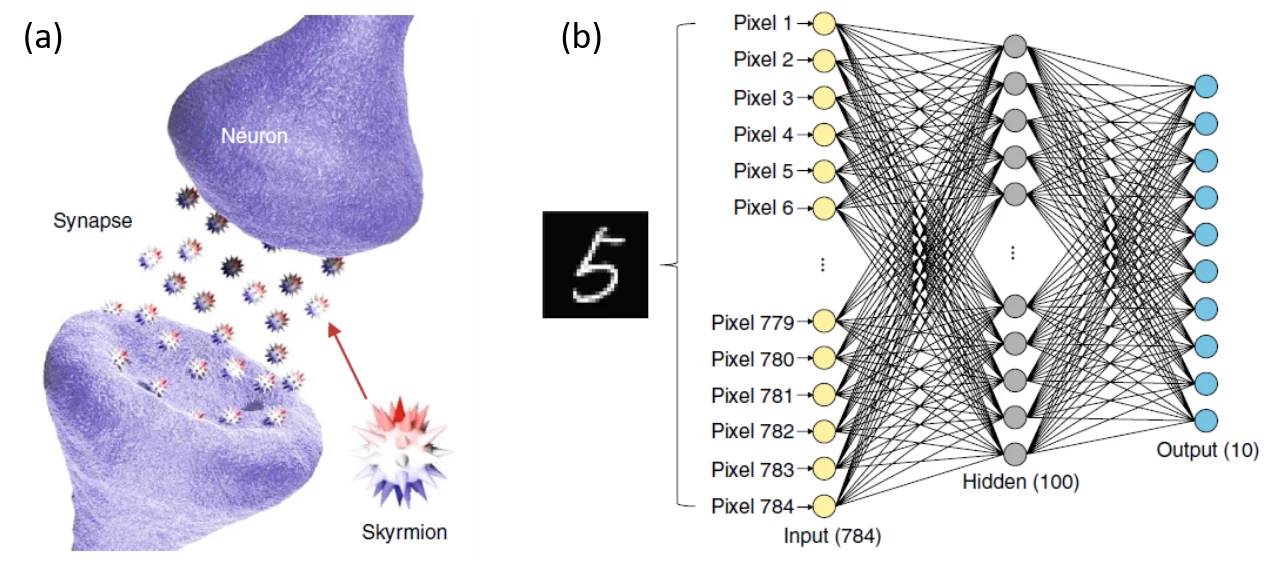Magnetic skyrmions are spin configurations that have become extremely popular with the spintronics research community in the last few years. Their popularity is due to a set of interesting properties that these magnetic states exhibit, which originate out of their non-trivial topology. A non-exhaustive list of these properties include efficient current-induced manipulation, a resistance against annihilation from pinning sites and defects, and the possibility to nucleate these spin states with diameters down to a few tens of nm. These properties have led to numerous proposals to use magnetic skyrmions as encoders for digital information, where the digital bits 1/0 are encoded in the presence/absence of the magnetic skyrmion.
Another potential application for magnetic skyrmions, exploiting some of their more exotic topology-induced properties, is to employ them to generate synaptic weights in artificial neural networks. This proposal was tested by an international collaboration of scientists, led by the Korea Institute of Technology and by the IBM Watson research center, who injected magnetic skyrmions into a patterned reservoir, and used the changes in the anomalous Hall effect caused by a change in the number of skyrmions present in the reservoir to change the synaptic weight in a one-neuron proof-of-principle neural network.
To visualize the magnetic configuration in the skyrmion reservoir, and to be able to directly correlate the change in the number of skyrmions present in the reservoir to the change in the anomalous Hall resistance, the researchers utilized the scanning X-ray transmission microscope installed at the PolLux endstation of the Swiss Light Source. Thanks to the combined magnetic imaging and electrical transport setup developed at the PolLux endstation, the researchers could observe that the synaptic weight of the patterned reservoir can be reliably and reproducibly changed by modifying the number of skyrmions present.
Using the data measured at the PolLux endstation, the research team performed device-level and system-level simulations of a skyrmionic artificial neural network, which was trained on pattern recognition using the MNIST handwritten dataset. The simulations resulted, after training, in a pattern recognition accuracy of 89%, comparable to the ideal software-based accuracy of 93%. Furthermore, system-level simulations revealed that a skyrmionic neural network could have important advantages compared to other technologies, such as e.g. an improved endurance and retention.
With these results, a first proof-of-principle of the applicability of magnetic skyrmions for neuromorphic computing was demonstrated.
Contacts:
Dr. Jörg Raabe
Swiss Light Source
Paul Scherrer Institut
Telephone: +41 56 310 5193
E-mail: joerg.raabe@psi.ch
Dr. Seonghoon Woo
IBM T.J. Watson Research Center
Telephone: +1 914-945-2572
E-mail: shwoo@ibm.com
Original Publication:
Skyrmion-based artificial synapses for neuromorphic computing
K.-M. Song, J.-S. Jeong, B. Pan, X. Zhang, J. Xia, S. Cha, T.-E. Park, K. Kim, S. Finizio, J. Raabe, J. Chang, Y. Zhou, W. Zhao, W. Kang, H. Ju, and S. Woo
Nature Electronics (2020)
DOI: 10.1038/s41928-020-0385-0
Other Media:
Highlight on the Device and Materials Engineering community – Nature Publishing Group
https://devicematerialscommunity.nature.com/users/357990-kyung-mee-song/posts/61801-magnetic-skyrmions-extend-their-potential-to-neuromorphic-computing-for-future-ai
